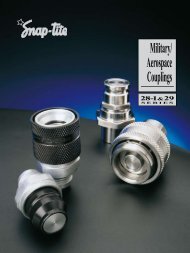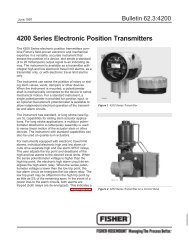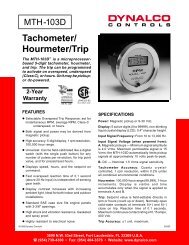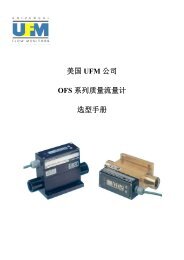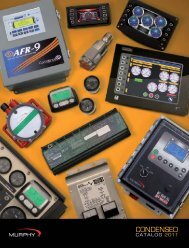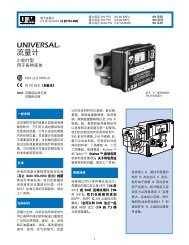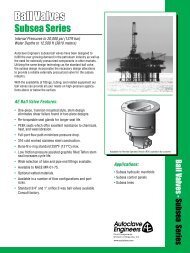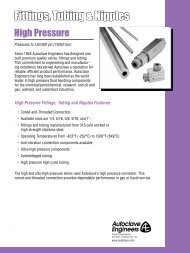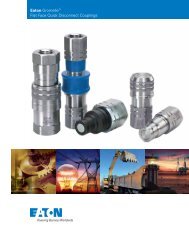Pressure
Pressure - 信德迈科技
Pressure - 信德迈科技
- No tags were found...
Create successful ePaper yourself
Turn your PDF publications into a flip-book with our unique Google optimized e-Paper software.
22<br />
<strong>Pressure</strong> switches<br />
Mechanical pressure switches<br />
General information about<br />
explosion protection<br />
Zone classification<br />
Explosion risk areas are grouped into zones according to the likelihood of a dangerous explosive<br />
atmosphere according to EN 1127-1 occurring.<br />
When assessing the explosion hazard, i.e. when identifying explosion risk areas, the “Guidelines for<br />
the Avoidance of Danger due to Explosive Atmospheres with Examples (ExRL)” of the German<br />
Insurance Association for the Chemical Industry [Berufsgenossenschaft Chemie] must be taken into<br />
account.<br />
If the situation concerns a special case or if doubts exist as to the definition of explosion risk areas, the<br />
matter shall be decided by the supervisory authorities (Trade Supervisory Office [Gewerbeaufsichtsamt],<br />
where applicable with the assistance of the Insurance Association or the Technical Control<br />
Boards [Technische Überwachungsvereine]).<br />
In Zones 0 (20) and 1 (21), only electrical equipment for which a type test certificate has been issued<br />
by a recognized testing agency may be used. In Zone 0 (20), however, only equipment expressly<br />
authorized for that zone may be used. Equipment approved for use in Zones 0 (20) and 1 (21) may<br />
also be used in Zone 2 (22). Under the new European Directive 94/9 EC (ATEX 100a), a distinction is<br />
made between gas atmospheres and dust atmospheres. This results in the following zone classifications:<br />
Gas<br />
Dust<br />
Zone 0<br />
Zone 0 (gas) is a place in which a dangerous explosive<br />
atmosphere is present continuously or for long periods. This<br />
normally includes only the interior of containers or the interior<br />
of apparatus (evaporators, reaction vessels etc.), if the conditions<br />
of Zone 0 are fulfilled. Continuous danger > 1000<br />
hours/year.<br />
Zone 1 occasionally Zone 1 (gas) is a place in which a dangerous explosive<br />
atmosphere can be expected to occur occasionally in normal<br />
operation. This may include the immediate vicinity of Zone 0.<br />
Occasional danger = 10 to 1000 hours/year.<br />
Zone 2<br />
Zone 20<br />
continuously or<br />
for long periods<br />
seldom and for<br />
short periods<br />
continuously or<br />
for long periods<br />
Zone 2 (gas) is a place in which a dangerous explosive<br />
atmosphere can be expected to occur only rarely and then<br />
only for short periods. This may include areas surrounding<br />
Zones 0 and/or 1. Danger only under abnormal operating conditions<br />
< 10 hours/year.<br />
Zone 20 (dust) is a place in which a dangerous explosive<br />
atmosphere in the form of a cloud of dust in air is present<br />
continuously or for long periods, and in which dust deposits of<br />
unknown or excessive thickness may be formed. Dust<br />
deposits on their own do not form a Zone 20. Continuous<br />
danger > 1000 hours/year.<br />
Zone 21 occasionally Zone 21 (dust) is a place in which a dangerous explosive<br />
atmosphere in the form of a cloud of dust in air may occasionally<br />
occur in normal operation, and in which deposits or layers<br />
of inflammable dust may generally be present. This may also<br />
include the immediate vicinity of Zone 20. Occasional danger<br />
= 10 to 1000 hours/year.<br />
Zone 22<br />
seldom and for<br />
short periods<br />
Zone 22 (dust ) is a place in which a dangerous explosive<br />
atmosphere may be expected to occur only rarely and then<br />
only for short periods. This may include areas in the vicinity of<br />
Zones 20 and 21. Danger only under abnormal operating conditions<br />
< 10 hours/year.





